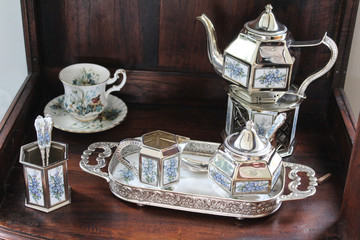Silver Antiques can be found in a wide variety of forms and styles. It ranges from sterling silver and plated silver to silver plate. The value of these items can depend on a number of factors, including whether a specific company manufactured them or if they are a relic of a certain time. Identifying a manufacturer and the silver piece’s design and pattern can help establish its history. There are also a few hallmarks to consider.

Sterling silver has melt value. There are many ways to value antique sterling silver. The value of an item depends on the amount of silver in the piece, its weight, the era it was made, and its history. One of the best methods to get an idea of the total value of your collection is by checking the current spot price of silver. The spot price changes frequently. If your collection is worth more than today’s spot price, you may be able to get a better deal if you sell it now.
Another good way to estimate your collection’s value is to look at the hallmarks of your items. These marks can tell you the purity of the silver, when the item was manufactured, and when it was marketed. Silverplate is a type of houseware that is made of a thin coating of silver over a base metal. Depending on the pattern, the plate can be sold for a melt or collector’s value.
Silverplate has sentimental value. Silver plate has a lot of sentimental value, though the amount of silver plate you can get for your money is often minimal. However, a nice set can be a good investment. You can sell them on eBay, or even via garage sales. One of the first things to consider is the age and condition of the item. This will determine its resale value. A piece that is pristine may be worth several hundred dollars, while a piece that is worn might only fetch a few dollars.
The pattern and design of the item will also affect its value. Some patterns are rare and therefore worth more. Other patterns are mediocre and will only be worth a few bucks. You can also check for hallmarks on the item. These marks are usually used to tell you the manufacturer of the piece. Identifying hallmarks is important because dishonest makers have been known to stamp fake metal.
Common hallmarks. There are many hallmarks used on silver antiques. They can tell you a lot about the piece, such as the origin and the content of the silver. One of the most commonly used hallmarks is the scales hallmark. This symbol certifies that the silver was made to the specifications laid out in a 1976 convention.
Other common hallmarks are the lion passant and the figural matchsafe. Neither is a new invention, but the lion passant has been around for over 200 years. The figural matchsafe has a very similar design to a 19th century original by Wallace. In the modern day, the lion passant is no longer required on sterling silver. Antique silver is marked with a variety of symbols to indicate the purity of the silver and the date of assay. These marks are sometimes confusing to collectors, especially since they are changed periodically.
Identifying the manufacturer and pattern. Identifying the manufacturer and pattern of silver antiques can be challenging. However, it is not impossible. The Internet offers a great deal of resources. You can search through websites that feature photos and details of silverware patterns. A good reference to identifying a manufacturer and pattern is the Silverplate Maker’s Mark Encyclopedia. This resource includes more than 2,000 illustrated maker’s marks and brief histories of more than 1,400 manufacturers.
Another resource to use when identifying the manufacturer and pattern of silver antiques is the Online Encyclopedia of Silver Marks. This resource explains the differences between sterling and silverplate, provides historical information on silverplate makers, and includes cross-references of more than 1,600 manufacturers. If you are unsure of a pattern, it is always a good idea to take a look at the original receipt for your silver. The date and manufacturer will tell you a lot about the piece.